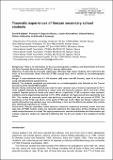Traumatic Experiences of Kenyan Secondry School Students

View/
Publication Date
2007Author
FA Ongecha-owuor, LI Khasakhala, VN Mutiso, G Odhiambo, DA Kokonya
Metadata
Show full item recordAbstract/
There is no information on the socio-demographic variations and determinants of Trauma and Post-Traumatic Stress Disorder (PTSD) in Kenyan adolescents. Objectives: To describe the traumatic experiences of Kenyan high school students and to determine the levels of Post-traumatic Stress Disorder (PTSD) among them, and in relation to sociodemographic variables. Design: A cross-sectional study of 1 110 students (629 males and 481 females), aged 12 to 26 years, using self-administered questionnaires. Method: The students completed questionnaires on sociodemographic data followed by the Trauma Checklist and the Child PTSD Checklist. Results: Being confronted with bad news was the most common type of trauma encountered in 66.7% of the subjects, followed by witnessing a violent crime and domestic violence; 23.2% and 16.5% of the subjects reported physical abuse and sexual abuse respectively. PTSD symptoms were common; avoidance and re-experiencing occurred in 75% of the students and hyperarousal was reported by over 50%. The number of traumatic events was positively correlated with the occurrence of PTSD. The prevalence of full PTSD was 50.5%, while partial PTSD was 34.8%. Male and female subjects were equally affected but the boarders were more affected (p < 0.05) and the differences between the schools were statistically significant (p = 0.000). Conclusions: Kenyan secondary school students commonly experience traumatic events and have high rates of PTSD. Further studies are needed to determine the implications of these findings for their health and performance in school. The coping mechanisms need to be delineated and interventions put in place. Long-term studies are required to determine the role of such events in the causation of mental illness.
